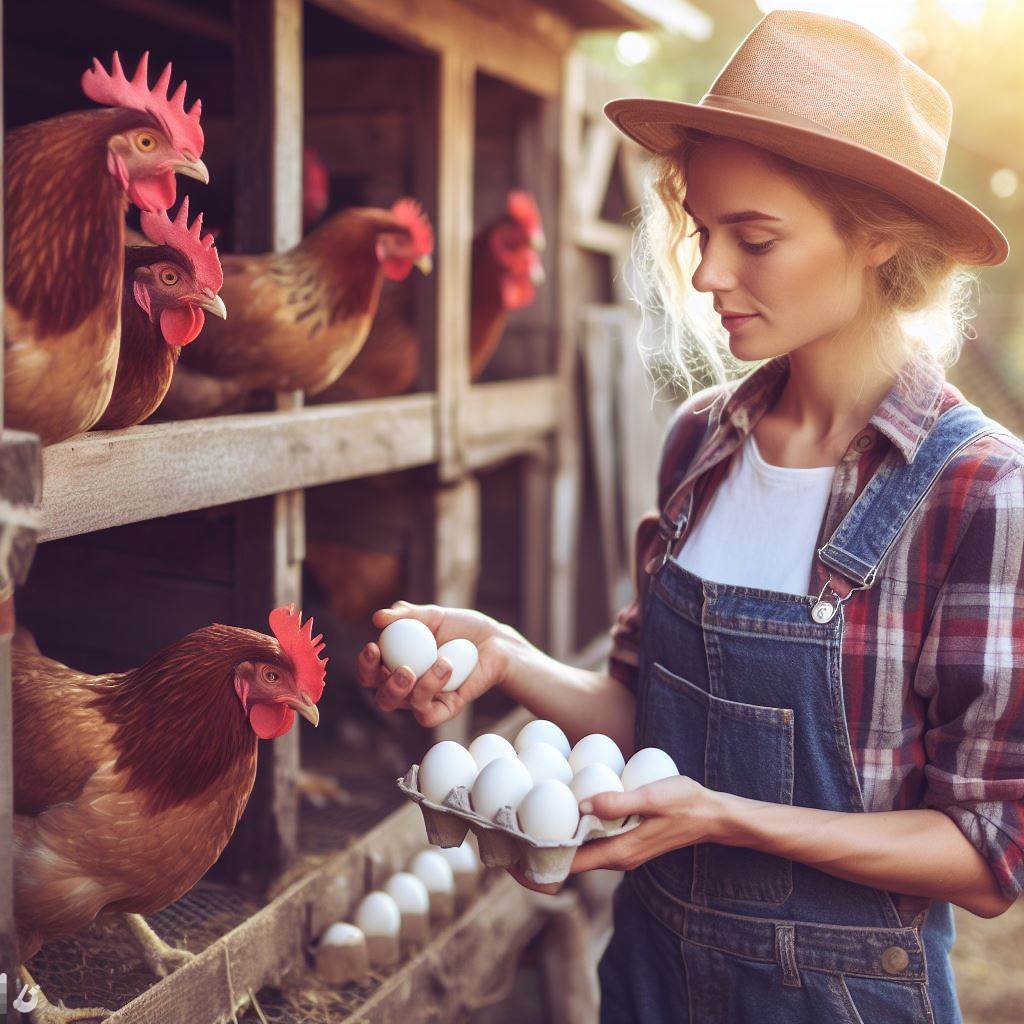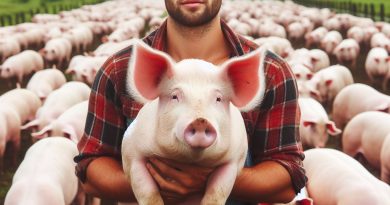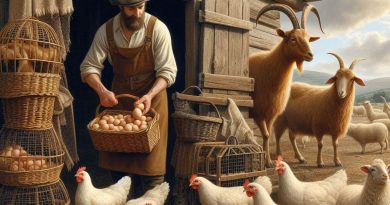Poultry Management: Key Practices Revealed
Last Updated on March 2, 2024
Introduction
Efficient poultry management is crucial for the success and profitability of poultry farms.
In this blog post, we will explore key practices that can help poultry farmers achieve higher productivity and better outcomes.
Importance of Efficient Poultry Management
Effective poultry management ensures proper care, hygiene, and nutrition for the birds.
It maximizes flock health and welfare, ultimately leading to higher meat and egg production.
Neglecting proper management can result in disease outbreaks and reduced profitability.
Overview of Key Practices Revealed in the Blog Post
This blog post will reveal essential practices for successful poultry management.
We will discuss the importance of biosecurity measures, such as controlled access and regular disinfection, to prevent disease transmission.
Additionally, we will highlight the significance of proper ventilation and temperature control in poultry houses to ensure optimal bird comfort and productivity.
We will explore the significance of quality feed and water management, including proper formulation and regular testing.
These practices are essential for providing birds with the necessary nutrients and preventing waterborne diseases.
Moreover, we will discuss the importance of observing and addressing any signs of stress, injury, or disease promptly.
Regular health monitoring, vaccinations, and early intervention are essential to maintain flock health and productive outcomes.
Lastly, the blog post will emphasize the significance of record keeping and data analysis for efficient management decisions.
Monitoring growth rates, feed conversion ratios, and mortality rates can help identify areas for improvement and drive better overall performance.
In short, adopting these key practices in poultry management can significantly impact the success and profitability of poultry farms.
With careful attention to detail and proactive management, poultry farmers can achieve higher productivity and healthier flocks.
Poultry Housing
Importance of appropriate housing for poultry
- Appropriate housing ensures the well-being and productivity of poultry.
- It provides protection from extreme weather conditions and predators.
- Adequate space and comfort promote healthy growth and minimize stress among the birds.
- Proper housing also facilitates efficient management of the flock and disease control.
- Good ventilation and temperature control in housing are essential for optimal bird performance.
Types of housing structures for different poultry species
- Open-sided houses with roofs are suitable for raising broilers, turkeys, and ducks.
- Cage systems are commonly used for layer chickens, allowing easy collection of eggs.
- Free-range or pasture-based systems are excellent for backyard poultry, ensuring access to outdoor environments.
Considerations for proper ventilation and temperature control in poultry housing
- Ventilation is crucial as it removes excess moisture, harmful gases, and odors from the poultry house.
- Natural ventilation can be achieved through carefully designed windows, doors, and air inlets.
- Mechanical ventilation systems, such as fans and air pumps, are used in enclosed poultry houses.
- The temperature should be monitored and controlled to maintain a comfortable and stress-free environment.
- Heat lamps, curtains, and insulation may be employed to manage temperature fluctuations.
- Adequate air circulation helps prevent respiratory diseases and keeps the bedding dry.
- Regular cleaning and disinfection of housing structures are vital to maintain hygiene and prevent diseases.
- Lighting systems are implemented to optimize bird growth, reproduction, and egg production.
- Using appropriate lighting techniques, such as artificial daylength control, enhances poultry management.
- The choice of housing equipment and materials should prioritize durability, safety, and ease of maintenance.
Proper poultry housing is essential for successful poultry management.
A suitable housing structure provides protection, comfort, and space for the birds, ensuring their well-being and productivity.
Different poultry species require specific housing types and environments, whether it’s open-sided houses, cage systems, or free-range setups.
Ventilation plays a crucial role in maintaining air quality by removing excess moisture and harmful gases, while temperature control ensures a comfortable and stress-free environment.
Mechanical ventilation systems, heat lamps, curtains, and insulation can be utilized for optimum temperature management.
Additionally, adequate air circulation, regular cleaning, and disinfection of housing structures prevent diseases and maintain hygiene.
Lighting systems, using appropriate techniques, maximize bird growth, reproduction, and egg production.
The choice of housing equipment and materials should prioritize durability, safety, and ease of maintenance.
By carefully considering these factors, poultry farmers can create a conducive housing environment that promotes the overall health and productivity of their flock.
Read: Sheep Flock Care: Top Strategies & Insights
Feeding and Nutrition
Essential nutrients for healthy poultry growth and development
- Poultry require a combination of protein, carbohydrates, fats, vitamins, minerals, and water to thrive.
- Protein is crucial for muscle development, while carbohydrates provide energy for various bodily functions.
- Fats are essential for hormone production, insulation, and absorption of certain vitamins.
- Vitamins and minerals are necessary for proper metabolism and cellular activity.
- Water is vital for digestion, nutrient absorption, thermoregulation, and waste removal.
Different types of poultry feeds available
- Commercial feeds: Convenient and formulated to meet the specific nutritional needs of poultry.
- Complete feeds: Provide a balanced mix of all necessary nutrients in a single feed.
- Supplemental feeds: Used in conjunction with complete feeds to enhance specific nutrient intake.
- Scratch grains: Whole grains like corn, wheat, and barley that provide energy and stimulation for poultry.
- Grit: Small, hard particles like oyster shell or granite that help birds grind feed in their gizzards.
Rations for different stages of poultry growth
- Starter feed: High-protein diet for chicks up to six weeks old, promoting rapid growth and development.
- Grower feed: Lower protein content for young birds between six to sixteen weeks old, supporting steady growth.
- Finisher feed: Lower protein and higher energy formulation for birds close to market weight.
- Laying feed: Specifically designed for hens to support egg production with added calcium.
Formulating a balanced diet for optimum performance
- Consider the nutrient requirements, body weight, growth rate, and breed of your poultry when formulating a diet.
- Consult with nutritionists, poultry specialists, or use pre-formulated feeds to ensure a balanced diet.
- Monitor the birds’ response to the diet and adjust as necessary to optimize performance.
Feeding schedules and practices for efficient poultry management
- Establish a consistent feeding schedule to promote bird health and productivity.
- Provide feed at regular intervals, preferably in the morning and evening.
- Feeders should be clean, easily accessible, and appropriate for the size and age of the birds.
- Monitor feed consumption and adjust quantities accordingly to avoid wastage and overfeeding.
- Ensure a clean and continuous water supply for proper hydration and digestion.
- Dispose of any leftover feed to prevent contamination or spoilage.
All in all, providing poultry with essential nutrients, choosing the right type of feed, formulating balanced diets, and implementing proper feeding schedules are key practices for successful poultry management.

Health and Disease Management
Importance of biosecurity measures to prevent disease outbreaks
In poultry management, biosecurity measures play a crucial role in preventing disease outbreaks.
Proper biosecurity practices are essential to maintain the health and productivity of the flock.
Biosecurity refers to a set of measures implemented to prevent the introduction and spread of diseases within the poultry farm.
These measures include controlling the movement of people, vehicles, and equipment on the farm, as well as monitoring and restricting access to the farm.
Implementing strict biosecurity protocols minimizes the risk of disease transmission from contaminated substances, such as feed, water, or equipment.
It also reduces contact between poultry and wild birds or other animals that can carry diseases.
Regular disinfection of poultry houses, equipment, and vehicles is a key component of biosecurity.
This helps in eliminating or reducing disease-causing microorganisms present in the environment and prevents their entry into the farm.
Restricting visitors and ensuring proper cleaning and disinfection of footwear and clothing can significantly reduce the introduction of diseases onto the farm.
Regular health check-ups and vaccinations for poultry
Poultry owners must prioritize regular health check-ups and vaccinations to maintain the overall well-being of the birds.
Regular health check-ups by trained veterinarians enable early detection of diseases and facilitate prompt treatment.
These check-ups involve thorough examinations of the birds, including observation of their behavior, physical examination, and collection of samples for laboratory testing if necessary.
Vaccinations are a vital preventive measure against various poultry diseases.
Vaccines help prepare the birds’ immune systems to fight off specific pathogens and reduce the severity of the disease if infection occurs.
It is crucial to follow a proper vaccination schedule recommended by veterinarians.
Vaccines may be administered through drinking water, spray, or injection, depending on the specific vaccine and the age of the birds.
Regular health check-ups and vaccinations not only contribute to the individual bird’s well-being but also safeguard the entire flock’s health and productivity
Tips for maintaining good hygiene in poultry houses
- Maintaining good hygiene in poultry houses is essential to prevent the spread of diseases and minimize stress among the birds.
- Regular cleaning and disinfection of poultry houses help eliminate disease-causing microorganisms, parasites, and pathogens that can threaten the flock’s health.
- It is important to remove litter and manure regularly, as they can harbor bacteria and attract pests. Clean and disinfect all equipment, including feeders and waterers, to maintain cleanliness and prevent contamination.
- Providing proper ventilation in poultry houses is crucial to minimize humidity and ammonia levels, which can predispose the birds to respiratory problems.
- Regular inspection of the birds’ living environment helps identify any potential hazards or issues that require immediate attention.
- Adequate space, appropriate temperature, and access to clean water are essential for the birds’ overall health and well-being.
Common poultry diseases and methods of prevention and treatment
- Several common poultry diseases can significantly impact the health and productivity of the flock. Understanding these diseases and their prevention methods is vital for successful poultry management.
- Some common poultry diseases include avian influenza, Newcastle disease, infectious bronchitis, and coccidiosis.
- Prevention methods vary depending on the disease but may include vaccination, strict biosecurity practices, and proper sanitation.
- Regularly monitoring the birds’ health and promptly isolating and treating sick birds can also help prevent disease spread.
- Veterinarians play a crucial role in diagnosing and treating poultry diseases. Consulting with a veterinarian and following their advice regarding disease prevention and treatment can significantly improve the overall health and well-being of the flock.
- Early intervention and proactive disease management practices are essential for minimizing the economic losses and negative impacts caused by poultry diseases.
Read: 5 Essential Tips for Healthy Cattle Rearing
Reproduction and Breeding
A successful poultry management system requires a thorough understanding of the reproductive cycle of poultry.
Breeding and reproduction play a crucial role in achieving desired traits in a flock.
In this section, we will explore the key practices for managing reproduction and breeding in poultry.
Understanding the Reproductive Cycle of Poultry
- Female poultry, known as hens, undergo a monthly reproductive cycle similar to mammals.
- The reproductive cycle includes an egg production phase, followed by a resting phase.
- During the egg production phase, hens’ hormone levels rise, triggering the release of mature eggs.
- A successful mating is required to fertilize these eggs and initiate the development of embryos.
- If the eggs are not fertilized, the hen will enter a resting phase until the next cycle begins.
Recommended Breeding Methods and Techniques
- Selective breeding is a commonly used method to improve desirable traits within a poultry flock.
- It involves choosing parent birds with the desired characteristics and mating them to produce offspring with those traits.
- Line breeding is a technique that involves breeding closely related birds within the same family line.
- Outcrossing, on the other hand, involves mating birds from different bloodlines to introduce new genetic diversity.
- Both methods have their advantages and disadvantages, and the choice depends on the specific breeding goals.
Selecting and Managing Breeding Stock for Desired Traits
- The selection process for breeding stock should focus on identifying birds with the desired traits.
- Traits such as growth rate, egg production, feather color, and disease resistance should be considered.
- It is important to conduct regular health checks and cull birds that do not meet the desired standards.
- Proper nutrition and housing are crucial for maintaining the health and productivity of breeding stock.
- Providing suitable nesting areas and maintaining cleanliness is essential to ensure successful egg production.
Tips for Successful Artificial Insemination in Poultry
- Artificial insemination (AI) is a technique used to introduce desired genetic material into a flock.
- Proper training and expertise are essential for successful AI in poultry.
- Maintaining strict hygiene during the process is crucial to avoid contamination and reduce the risk of infections.
- Collecting and handling semen carefully is vital to preserve the quality of genetic material.
- Implementing AI can help breeders achieve desired traits and improve the overall genetic potential of their flock.
In short, understanding the reproductive cycle, adopting suitable breeding methods, selecting and managing breeding stock, and implementing artificial insemination techniques are critical practices for successful poultry management.
By following these practices, poultry farmers can achieve their desired traits and maintain a healthy, productive flock.
Read: Climate-Smart Agri: Tech Against Climate Change
See Related Content: Top Breeds for Profitable Pig Farming
Delve into the Subject: Goat Hoof Trimming: A Step-by-Step
Waste Management and Environmental Considerations
The impact of poultry waste on the environment
- Poultry waste contains high levels of nitrogen and phosphorus.
- When not properly managed, poultry waste can contaminate water sources.
- Excessive nutrients from poultry waste can lead to algal blooms and water pollution.
- Waste runoff can also contribute to soil degradation and nutrient imbalances.
Effective waste management practices for poultry farms
- Implement a comprehensive waste management plan.
- Regularly monitor waste collection and storage systems to prevent leakage.
- Utilize proper ventilation systems to minimize odors.
- Train staff on proper waste handling and disposal techniques.
- Adopt technologies like anaerobic digestion to convert waste into bioenergy.
Utilizing poultry waste as a resource for composting and fertilization
- Composting poultry waste can help reduce environmental impact and produce valuable soil amendments.
- Ensure proper mixing of waste with carbon-rich materials like straw or sawdust.
- Composted poultry waste can improve soil structure, nutrient content, and water-holding capacity.
- Apply composted waste to agricultural fields to enhance crop growth and reduce the need for synthetic fertilizers.
Effective waste management is essential for poultry farms to:
- Reduce environmental impact and maximize resource utilization.
- Prevent water contamination and algal blooms caused by nitrogen and phosphorus in poultry waste.
Implementing a comprehensive waste management plan involves:
- Regular monitoring of waste collection and storage systems.
- Installation of effective ventilation systems to minimize odors.
- Equipping staff with proper training on waste handling, disposal techniques, and adherence to regulations.
Adopting advanced technologies like anaerobic digestion can:
- Convert poultry waste into bioenergy, reducing waste volume.
- Provide an alternative energy source for the farm.
Utilizing poultry waste through composting involves:
- Controlled decomposition to produce nutrient-rich soil amendments.
- Mixing waste with carbon-rich materials for optimal composting.
Composted poultry waste enhances:
- Soil structure, nutrient content, and water-holding capacity.
- Crop growth, reducing dependence on synthetic fertilizers.
In fact, implementing effective waste management practices in poultry farming minimizes environmental impact and promotes sustainable resource utilization.
Read: Livestock Tech: Innovations in Animal Farming
Conclusion
Recap of the key practices for effective poultry management
In this section, we have discussed several key practices for effective poultry management.
These practices include proper housing, nutrition, biosecurity, and disease prevention.
Emphasizing the importance of implementing these practices
Implementing these practices is crucial for ensuring the health and well-being of the poultry flock.
Proper housing and nutrition promote growth and productivity, while biosecurity measures prevent the spread of diseases.
Encouraging ongoing education and research for continuous improvement in poultry management
As new information and technologies emerge, it is essential for poultry farmers to stay updated and adapt their management practices accordingly.
Ongoing education and research can help identify innovative solutions and improve overall poultry management.
In closing, effective poultry management requires the implementation of key practices such as proper housing, nutrition, biosecurity, and disease prevention.
By adhering to these practices and staying informed through ongoing education and research, poultry farmers can achieve success and ensure the long-term sustainability of their operations.


